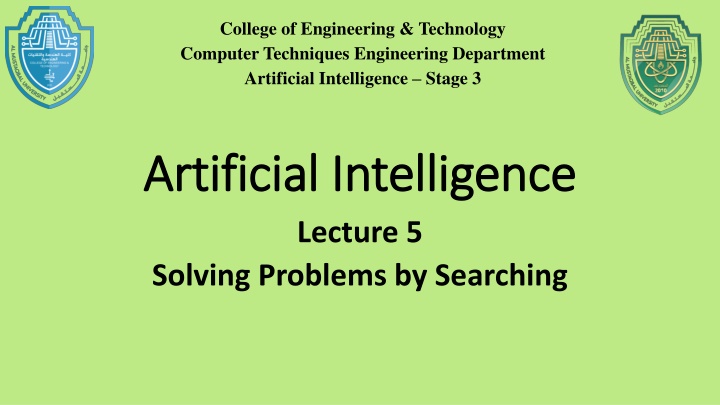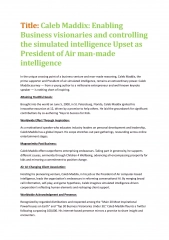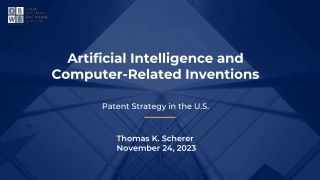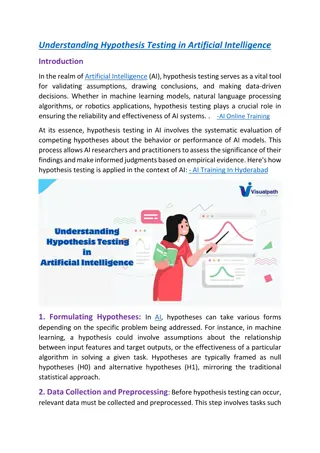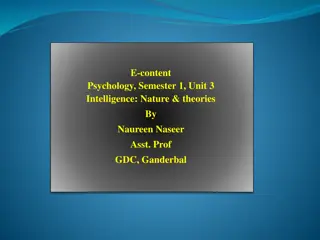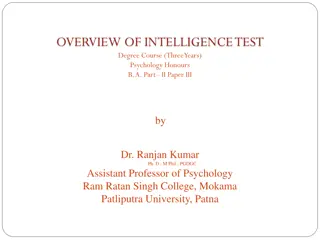Artificial Intelligence
In this lecture on artificial intelligence, explore the use of informed search strategies such as greedy best-first search to efficiently find solutions leveraging problem-specific knowledge beyond the problem definition. Understand how heuristic functions play a key role in guiding the search algorithms towards optimal solutions. Dive into examples showcasing the application of these strategies in route-finding problems and gain insights into the strengths and limitations of greedy approaches in problem-solving scenarios.
Download Presentation

Please find below an Image/Link to download the presentation.
The content on the website is provided AS IS for your information and personal use only. It may not be sold, licensed, or shared on other websites without obtaining consent from the author.If you encounter any issues during the download, it is possible that the publisher has removed the file from their server.
You are allowed to download the files provided on this website for personal or commercial use, subject to the condition that they are used lawfully. All files are the property of their respective owners.
The content on the website is provided AS IS for your information and personal use only. It may not be sold, licensed, or shared on other websites without obtaining consent from the author.
E N D
Presentation Transcript
College of Engineering & Technology Computer Techniques Engineering Department Artificial Intelligence Stage 3 Artificial Intelligence Artificial Intelligence Lecture 5 Solving Problems by Searching
Informed Search Strategies (Heuristic Search) Informed Search Strategies (Heuristic Search) The informed (heuristic) search strategy uses problem specific knowledge beyond the definition of the problem to find solutions more efficiently. Heuristic functions are the most common form in which additional knowledge of the problem is imparted to the search algorithm. Greedy best-first search A* search
Greedy best Greedy best- -first Search first Search Greedy best-first search tries to expand the node that is closest to the goal. It evaluates nodes by using heuristic function h(n). For the route-finding problem in Romania ( Straight-line distance ) heuristic which we call hSLD.
Greedy best Greedy best- -first Search first Search hSLD(In(Arad)) = 366 which cannot be computed from the problem description.
Greedy best Greedy best- -first Search first Search Figure below shows the progress of greedy best search using hSLD to find a path from Arad to Bucharest.
Greedy best Greedy best- -first Search first Search The first node to expanded from Arad will be Sibiu because is closer to Bucharest than either Zerind or Timisoara. The next node to expanded will be Fagaras because it is closest. Fagaras in turn generates Bucharest, which is the goal. The search cost is minimal. It is not optimal The path via Sibiu and Fagaras to Bucharest is 32 kilometers longer that the path through Rimnicu Vilcea and Pitesti.
Greedy best Greedy best- -first Search first Search This show why the algorithm is called greedy at each step it tries to get as close to the goal as it can. Greedy best-first tree search is also incomplete. Consider the problem of getting from Iasi to Fagaras. The heuristic suggests that Neamt be expanded first because it is closest fo Fagaras, but it is a dead end. The solution is to go first to Vaslui a step that is actually farther from the goal according the heuristic and then to continue to Urziceni, Bucharest, and Fagaras. The algorithm will never find this solution, however, because expanding Neamt puts Iasi back inot the frontier, Iasi is closer to Fagaras than Vaslui is, and so Iasi will be expanded again, leading to an infinite loop.
Greedy best Greedy best- -first Search first Search Find the path from S to a goal nod using Greedy best-first search and the give domain knowledge. Cost to Goal Node S 5 A 7 B 3 C 4 D 6 E 5 F 6 G1,G2,G3 0
A* Search A* Search A* search evaluates nodes by combining g(n), the cost to reach the node, and h(n), the cost to get from the node to the goal: f(n) = g(n) + h(n) since g(n) gives the path cost from the start node to node n, and h(n) is the estimated cost of the cheapest path from n to the goal, we have f(n) = estimate cost of the cheapest solution through n. A* search is both complete and optimal.
A* Search A* Search The following figure explain how to travel from Arad to Bucharest using A* algorithm.
A* Search A* Search
A* Search A* Search Find the path from S to a goal nod using A* search and the give domain knowledge. Cost to Goal Node S 5 A 7 B 3 C 4 D 6 E 5 F 6 G1,G2,G3 0
Thanks for Your Attention Thanks for Your Attention
